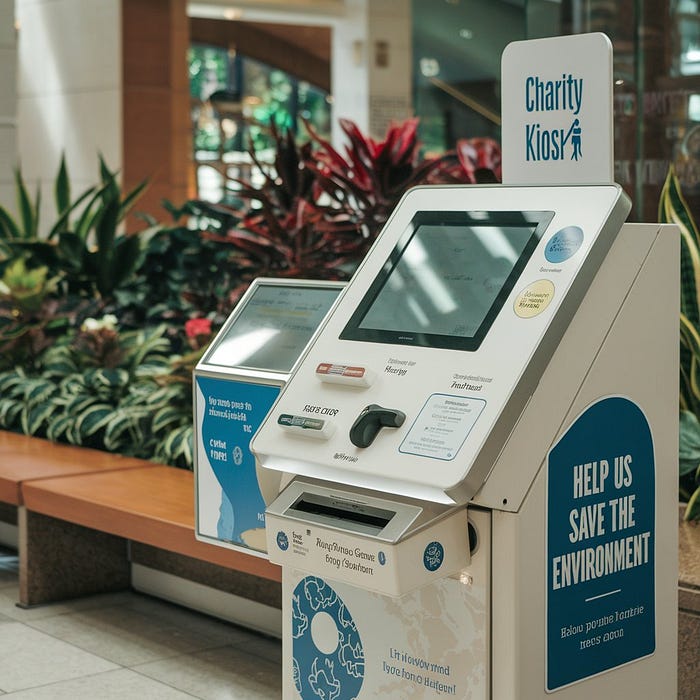The Rise of Self-Service Kiosks in the Charity Sector

Case Study: The Red Cross and Self-Service Kiosks
Implementation Strategy
The Red Cross, known for its humanitarian aid initiatives, introduced self-service kiosks at fundraising events to streamline donations. The implementation process involved:
- Assessing Needs: Identifying the most effective locations and event types for kiosk placement.
- Software Integration: Ensuring kiosks were integrated with the organization’s existing donation platform.
- User-Friendly Interface Design: Developing an intuitive interface for seamless donor interactions.
- Deployment and Testing: Rolling out kiosks at pilot events and making necessary adjustments.
- Marketing and Awareness: Informing potential donors about the availability and ease of using self-service kiosks.
Results and Metrics
The Red Cross saw a significant increase in donations after implementing self-service kiosks. Key metrics include:
- 30% increase in donations at events with kiosks compared to traditional donation methods.
- Faster transaction times, reducing wait times for donors.
- Higher donor retention rates, as repeat donors found the system convenient and engaging.
Donor Engagement and Experience
Self-service kiosks enhanced donor engagement by providing a quick and hassle-free donation process. Features such as preset donation amounts, contactless payment options, and real-time donation tracking improved the overall donor experience. Additionally, donors appreciated the transparency, as the kiosks displayed how their contributions would be utilized.
Challenges Faced and Overcome
Despite its success, the Red Cross encountered some challenges during implementation:
- Technical issues: Initial software glitches required updates and maintenance.
- Donor hesitation: Some donors were unfamiliar with kiosks, requiring on-site guidance.
- Connectivity concerns: In areas with poor internet access, mobile hotspots were used to ensure functionality.
The World Wildlife Fund (WWF): Enhancing Donations
Kiosk Features and Functionalities
WWF implemented self-service kiosks with unique features to encourage donor participation. These kiosks included:
- Interactive touchscreens displaying information on endangered species.
- Augmented reality (AR) experiences, allowing donors to visualize their impact.
- Multi-language support to cater to a global donor base.
Impact on Fundraising Events
WWF saw a significant transformation in fundraising events due to kiosk integration. Donors could quickly contribute without the need for cash, leading to:
- A 40% increase in on-site donations.
- Reduced administrative costs, as kiosks automated donor data collection.
- Enhanced engagement, with donors spending more time learning about conservation efforts.
Sustainability Initiatives
As an environmentally focused organization, WWF ensured its kiosks aligned with sustainability goals:
- Solar-powered kiosks to minimize carbon footprint.
- E-receipts instead of paper, reducing waste.
- Recycled materials used in kiosk construction.
User Feedback and Adaptation
User feedback played a crucial role in refining kiosk functionality. WWF collected input from donors and made the following adaptations:
- Enhanced touchscreen responsiveness for smoother interactions.
- Simplified donation steps for faster transactions.
- More language options to increase accessibility.
Local Food Banks: A Community Connection
Real-time Giving and Community Engagement
Local food banks have successfully integrated self-service kiosks to facilitate real-time giving. Donors can contribute directly at food distribution events, ensuring immediate impact. Benefits include:
- Instant transaction processing, allowing food banks to allocate resources faster.
- Community involvement, as donors see the direct results of their contributions.
- Recurring donations, with kiosks offering subscription-based giving options.

Partnerships with Local Businesses
Local businesses have played a pivotal role in enhancing kiosk effectiveness by:
- Hosting kiosks in high-traffic areas like supermarkets and shopping malls.
- Matching donations, doubling the impact of individual contributions.
- Providing technological support for maintenance and upgrades.
Adapting to Community Needs
Food banks have tailored kiosks to meet specific community requirements:
- Multi-currency acceptance for diverse donor demographics.
- Pre-set donation packages for purchasing food bundles.
- Integration with government assistance programs to complement public aid.
Success Stories and Testimonials
Food bank users and partners have shared positive experiences:
- “These kiosks make donating effortless. I can contribute while shopping for my groceries.”
- “Seeing my donation’s impact in real-time motivates me to give more.”
- “Businesses collaborating with food banks through kiosks have strengthened our community’s support network.”
Technical Considerations for Charities
Choosing the Right Kiosk Software
Selecting the right software is crucial for efficiency and user experience. Key features to consider:
- Seamless integration with existing CRM and donation platforms.
- Customizable interfaces to align with branding.
- Real-time tracking and analytics for monitoring contributions.
Hardware Selection and Maintenance
Durable and reliable hardware ensures long-term kiosk operation. Considerations include:
- Weather-resistant enclosures for outdoor placements.
- Touchscreen durability for frequent use.
- Regular maintenance schedules to prevent downtime.
Security Measures
Ensuring donor information and transactions are secure is paramount:
- End-to-end encryption for payment processing.
- PCI-compliant software to meet industry standards.
- Secure data storage to protect donor details.
User Training and Support
Training staff and volunteers is essential for effective kiosk operation. Key training areas:
- Basic troubleshooting to resolve minor issues.
- Guiding donors through the process when needed.
- Regular software updates to ensure optimal functionality.
Conclusion
The rise of self-service kiosks in the charity sector signifies a shift towards more efficient and accessible donation methods. Organizations like the Red Cross, WWF, and local food banks have demonstrated how kiosks can increase donations, enhance donor engagement, and align with sustainability goals. With ongoing technological advancements, the future of self-service kiosks in the charity sector looks promising, offering even more innovative ways to connect with donors and maximize impact.
Comments
Post a Comment